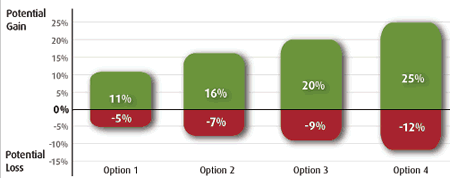As mentioned before, our goal when investing is to maximize the potential return for the amount of risk we decide to take. But how do you find that out? It seems the traditional way to decide this is through what financial planners call a Risk Questionnaire. You answer a series of multiple choice questions, and in the end it suggests an approximate asset allocation, usually telling you how much to put into stocks and how much in bonds.
Having more stocks give you higher overall returns, but higher volatility. Having more bonds does the opposite – it gives you lower returns, but decrease the up and down swings of your overall portfolio. Let’s try out some online risk surveys and see what comes out…
Here are some that I’ve found online, in no particular order:
Risk Surveys
1) Index Fund Advisors Risk Capacity Survey (Short or Long)
2) Hewins Financial Advisors Risk Questionnaire
3) SmartMoney.com Asset Allocator
4) Vanguard Risk Questionnaire
5) Amerivest Questionnaire
I won’t go into my exact answers for each survey, but let’s just say I tried to answer them all honestly and reasonably consistently the same. The goal was retirement in about 30 years.
Results
1) For both the 5 and 49 question surveys, I ended up being recommended their 85 Portfolio, which includes 95% Stocks, 5% Bonds.
2) I received the following insightful advice – “You can tolerate high loss. Your portfolio should have an emphasis on stocks.”
3) I ended up at about 65% Stocks, 20% Bonds, 15% Cash.
4) It recommended 100% Stocks.
5) The suggested portfolio was 90% Stocks, 10% Bonds.
After doing these surveys, I think it’s really hard for people to gauge how they would react to losing 30% of their assets in a year unless they had actually experienced it. I mean, they give you a graph like this:

and it looks so easy just to pick the one on the right. It’s a whole different atmosphere during an actual crash, with all the media frenzy and your friends freaking out. I know my parents bought more bonds back in 2001 or so. It’s probably a good idea to go a bit more conservative than suggested. The Financial Planning Assocation also did a study on this titled ‘Assessing Risk Tolerance: Questioning the Questionnaire Method’. (Long, but interesting read)
Still, let see what we get if I average all my results. I’ll throw out #2 for being vague. That leaves me (95+65+100+90)/4 = 87.5% Stocks. Hey, that’s actually pretty close! I’m thinking that we should have about 85% Stocks, 15% Bonds. Next is to figure out how to break down those stocks and bonds. I feel we should tilt our current holdings more towards small-cap and value stocks, as including them will improve our risk-adjusted returns.
 The Best Credit Card Bonus Offers – March 2024
The Best Credit Card Bonus Offers – March 2024 Big List of Free Stocks from Brokerage Apps
Big List of Free Stocks from Brokerage Apps Best Interest Rates on Cash - March 2024
Best Interest Rates on Cash - March 2024 Free Credit Scores x 3 + Free Credit Monitoring
Free Credit Scores x 3 + Free Credit Monitoring Best No Fee 0% APR Balance Transfer Offers
Best No Fee 0% APR Balance Transfer Offers Little-Known Cellular Data Plans That Can Save Big Money
Little-Known Cellular Data Plans That Can Save Big Money How To Haggle Your Cable or Direct TV Bill
How To Haggle Your Cable or Direct TV Bill Big List of Free Consumer Data Reports (Credit, Rent, Work)
Big List of Free Consumer Data Reports (Credit, Rent, Work)
Personally, I don’t think bonds make sense for the young individual investor. If it’s the yield you want, you’re better off with a money market instrument – similar, steady payout without the rate risk to the principal. Seems that the only time to take a position in bonds is in a declining Fed rate environment and a bearish market – but it’s difficult to time the market this way, so you might as well stick to all equities.
However, if one must have bonds at all, I’d go for TIPS, for a small 5-10% position, because of their unique inflation-beating mission. My 2 cents, kudos on the blog.
Good points, but don’t bonds tend to zig when stocks zag? In the long run, I would think the chance for loss of principal would be low.
I think it’s just as hard to time bonds as stocks. I agree that TIPs seem to be a good idea, I’ll have to see how I can buy them in my Vanguard account.
What software did you use to make that graph?
VIPSX for a TIPS Vanguard offering. If I remember right, you’ve read “The Intelligent Asset Allocator” which pretty clearly outlines that adding a small portion of bonds to a 100% stock portfolio actually increases returns and decreses risk due to their low correlation or the zig v. zag argument another poster made.
Your points are well-taken over the long haul, and the above risk/reward chart may be accurate over long historical periods (say 70+ years?). But, does it represent current risk/reward looking prospectively, where after a 18+ year secular equity & bond bull market followed by a 5+ year real estate market, we may very well be facing a secular bear market in equities, bonds, and real estate for 10, 15, maybe 20 years?
Consider The Journal of Financial Planning article entitled “Understanding Secular Bear Markets: Concerns and Strategies for Financial Planners” by Solow & Kitces. See fpanet.org. If professionals are thinking about switching up their investment strategies for the upcoming years, why are retail investors like ourselves still thinking that what worked in the 1980s and 1990s is good enough for us?